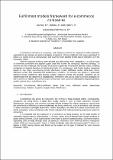| dc.description.abstract | E-commerce relevance is increasing, and companies should be prepared to fulfill customers’ expectations and ensure an optimal shopping experience. Online worldwide retail sales generated 70 billion U.S. dollars in 2019, being Mexico and Brazil the main leaders for this type of channel in LATAM (Chevalier, 2020).
With the objective of being more efficient and differentiate from competitors, it is vital to have an extremely consistent and aligned supply chain that follows the company's business strategy. To achieve this new challenge, the following study aims to generate a framework decision matrix, enabling companies to support decisions of introducing fresh, dry, refrigerated, and frozen product categories based on five major warehousing trends: distribution center, fulfillment center, dark-store, micro-fulfillment center and crowdsourced warehousing solutions. To develop this project a systematic literature review combining case studies, papers, research articles and experts’ validation will be implemented with the objective of establishing a framework that can be used to ensure strategies for the e-commerce retailers, thus they are able to serve and meet customer expectations regarding product quality, optimal price, and delivery time. | en_US |
